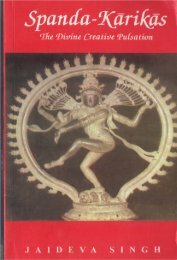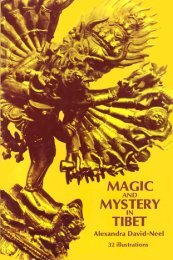Ashtavakra-Gita
Ashtavakra-Gita
Ashtavakra-Gita
You also want an ePaper? Increase the reach of your titles
YUMPU automatically turns print PDFs into web optimized ePapers that Google loves.
Translator’s Introduction<br />
The <strong>Ashtavakra</strong> <strong>Gita</strong> is an ancient spiritual document of great purity and<br />
power. Pure, because it is relentlessly one-pointed. Every word is aimed at<br />
triggering Self-realization--no suggestions for self-improvement, no rules for<br />
moral behavior, no practical wisdom for daily life. Powerful, because the mere<br />
reading—or repeated reading--of it can be enough to send a ripe mind reeling<br />
into Truth.<br />
Little is known about the <strong>Ashtavakra</strong> <strong>Gita</strong>. <strong>Ashtavakra</strong> is a name that<br />
appears in Indian lore, but almost certainly he did not write it. The author, likely<br />
an anonymous sage, merely uses the characters of <strong>Ashtavakra</strong> and King Janaka<br />
to set up a classic dialogue between guru and disciple. It quickly becomes a<br />
guru-guru dialogue, however, because after the first salvo of wisdom from<br />
<strong>Ashtavakra</strong>, Janaka realizes his true Self, and from then on they get into an<br />
advaitic jam session of the highest sort.<br />
Because of this, some translators have done away with the dialogue<br />
format and attributed everything to <strong>Ashtavakra</strong>. Indeed, since all the verses of<br />
the <strong>Ashtavakra</strong> <strong>Gita</strong> exist at the highest possible level of spoken wisdom, it would<br />
appear meaningless to attribute some to the teacher and some to his newlyenlightened<br />
disciple. There is nevertheless a story line set up in the <strong>Ashtavakra</strong><br />
<strong>Gita</strong>, and for me it goes something like this:<br />
Chapter 1: It all starts when King Janaka asks the sage <strong>Ashtavakra</strong> how he<br />
can attain Knowledge, detachment, liberation. <strong>Ashtavakra</strong> tells him.<br />
Chapter 2: It works! Upon hearing <strong>Ashtavakra</strong>’s words Janaka realizes his<br />
True Nature. Enraptured, he describes the joy and wonder of his new state.<br />
Chapter 3: <strong>Ashtavakra</strong> is delighted for Janaka but sees inconsistencies. He<br />
fires off a series of confrontational verses about attachment to worldly pleasure.<br />
Chapter 4: Janaka asserts that the Lord of the Universe can do as he<br />
pleases.<br />
Chapter 5: <strong>Ashtavakra</strong> does not disagree, but in a terse four verses points<br />
to the next step—dissolution.<br />
Chapter 6: Janaka says “I know that already,” matching him in style and<br />
number of verses.<br />
Chapter 7: Unable to leave it at that, however, Janaka goes on to further<br />
describe his enlightened state.<br />
Chapter 8: Still hearing too much “I” in Janaka’s language, <strong>Ashtavakra</strong><br />
instructs him in the subtleties of attachment and bondage.<br />
Chapter 9: <strong>Ashtavakra</strong> continues to describe the way of true detachment.<br />
Chapter 10: <strong>Ashtavakra</strong> hammers away at the folly of desire—no matter<br />
how elevated or subtle.<br />
Chapter 11: <strong>Ashtavakra</strong> further describes the state of desirelessness to<br />
which he points.





